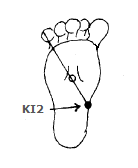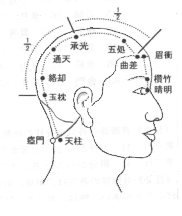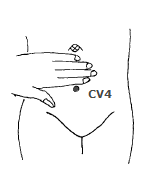- HOME »
- Meridians »
- Kidney Meridian(KI)
Kidney Meridian(KI) for Acupuncture and Moxabustion
Kidney Meridian(KI) 手少陰腎経
◐ KI-1 湧泉 ◐ KI-2 然谷 ◐ KI-3 太谿 ◐ KI-4 大鐘 ◐ KI-5 水泉 ◐ KI-6 照海 ◐ KI-7 復溜 ◐ KI-8 交信 ◐ KI-9 築賓 ◐ KI-10 陰谷 ◐ KI-11 横骨 ◐ KI-12 大赫 ◐ KI-13 気穴 ◐ KI-14 四満 ◐ KI-15 中注 ◐ KI-16 肓兪 ◐ KI-17 商曲 ◐ KI-18 石関 ◐ KI-19 陰都 ◐ KI-20 腹通谷 ◐ KI-21 幽門 ◐ KI-22 歩廊 ◐ KI-23 神封 ◐ KI-24 霊墟 ◐ KI-25 神蔵 ◐ KI-26 彧中 ◐ KI-27 兪府
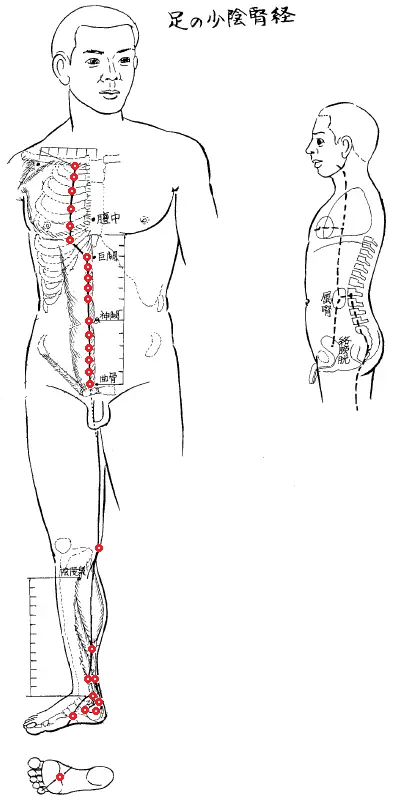
KI-1 湧泉
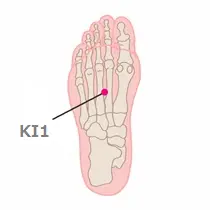

WHO : On the sole of the foot, in the deepest depression of the sole when the toes are flexed.
Note: When the toes are flexed, KI1 is located approximately in the depression at the junction of the anterior one third and the posterior two thirds of the line connecting the heel with the web margin between the bases of the second and third toes.
Use for : Cerebral anemia(with 手足末端穴&PC8), Kidney disease, Hot flashes, Earache, To enhance neural activity(with HT7, LU11, BL15),
KI-2 然谷
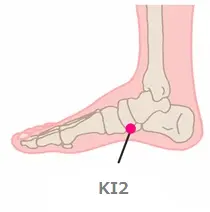
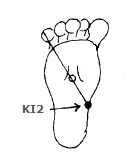
WHO : On the medial aspect of the foot, inferior to the tuberosity of the navicular bone, at the border between the red and white flesh.
Use for : Burning feet syndrome, Sore throat
KI-3 太谿
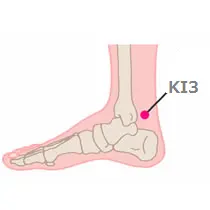
WHO : On the posteromedial aspect of the ankle, in the depression between the prominence of the medial malleolus and the calcaneal tendon.
Practical : Side of the prominence of the medial malleolus, find the pulse.
Use for : Mumps(with TE3), Bronchitis, Pleurisy, Sore throat, Ear problems
KI-4 大鐘
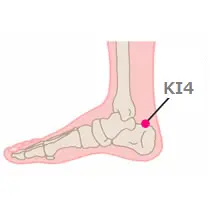
WHO : On the medial aspect of the foot, posteroinferior to the medial malleolus, superior to the calcaneus, in the depression anterior to the medial attachment of the calcaneal tendon.
Practical : Half size of the thumb from KI3.
Use for : Back pain
KI-5 水泉

WHO : On the medial aspect of the foot, 1 B-cun inferior to KI3, in the depression anterior to the calcaneal tuberosity.
Practical : One thumb down from KI3 and one thumb back from KI5.
Use for : Gynecological disease
KI-6 照海
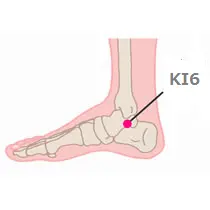
WHO : On the medial aspect of the foot, 1 B-cun inferior to the prominence of the medial malleolus, in the depression inferior to the medial malleolus.
Note: The corresponding lateral point to KI6 is BL62.
Practical : One thumb size down from the prominence of the medial malleolus.
Use for : Essential point for Gynecological disease, Irregular menstruation, Endometriosis, Fetal malposition, Intestinal colic, Ankle arthritis, Sprain
KI-7 復溜
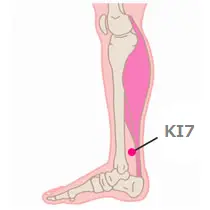
WHO : On the posteromedial aspect of the leg, anterior to the calcaneal tendon, 2 B-cun superior to the prominence of the medial malleolus.
Note: At the same level and posterior to KI8.
Practical : Double thumb size up from the prominence of the medial malleolus.
Use for : Kidney, Bladder, Gynecological disease, Boost sexual energy, Lower back pain, Hemorrhoid pain
KI-8 交信
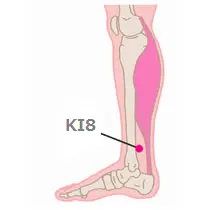
WHO : On the medial aspect of the leg, in the depression posterior to the medial border of the tibial bone, 2 B-cun superior to the prominence of the medial malleolus.
Note: 0.5 B-cun anterior to KI7.
Use for : Vaginal bleeding, Irregular menstruation, Colic(boys), Night sweats, Gonorrhea
KI-9 築賓
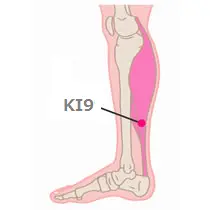
WHO : On the posteromedial aspect of the leg, between the soleus muscle and the calcaneal tendon, 5 B-cun superior to the prominence of the medial malleolus.
Note 1: With the knee flexed and the leg stretched (plantar flexion) against resistance, the soleus muscle can be seen more clearly along the medial border of the tibia bone.
Note 2: At the same level as LR5, on the line connecting KI3 with KI10.
Practical : Triple thumb size up from KI7 towards KI10. Slide up from malleolus by index finger. The point where the finger would be automatically stop is KI9. Triple thumb size up from KI8
Use for : Detoxification, Vomiting, Neuralgia, Scrotum problems for child
KI-10 陰谷
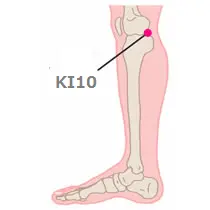
WHO : On the posteromedial aspect of the knee, just lateral to the semitendinosus tendon, in the popliteal crease.
Use for : Knee pain, Vaginal bleeding, Impotence, Gonorrhea
KI-11 横骨
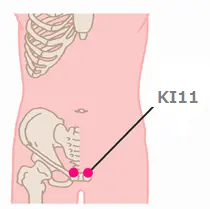
WHO : On the lower abdomen, 5 B-cun inferior to the centre of the umbilicus, 0.5 B-cun lateral to the anterior median line.
Practical : A half thumb from CV2.
Use for : Cystitis, Urethritis, Vaginitis, Gonorrhea
KI-12 大赫
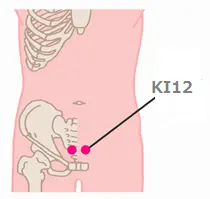
WHO : On the lower abdomen, 4 B-cun inferior to the centre of the umbilicus, 0.5 B-cun lateral to the anterior median line.
Use for : Cystitis, Urethritis, Impotence
KI-13 気穴
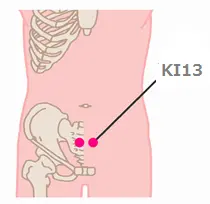
WHO : On the lower abdomen, 3 B-cun inferior to the centre of the umbilicus, 0.5 B-cun lateral to the anterior median line.
Use for : Fibroid, Irregular menstruation
KI-14 四満
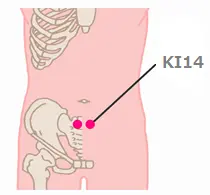
WHO : On the lower abdomen, 2 B-cun inferior to the centre of the umbilicus, 0.5 B-cun lateral to the anterior median line.
Use for :
KI-15 中注
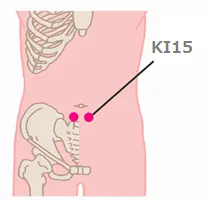
WHO : On the lower abdomen, 1 B-cun inferior to umbilicus, 0.5 B-cun lateral to the anterior median line.
Use for :
KI-16 肓兪
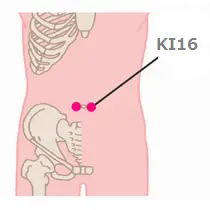
WHO : On the upper abdomen, 0.5 B-cun lateral to the centre of the umbilicus.
Use for :
KI-17 商曲
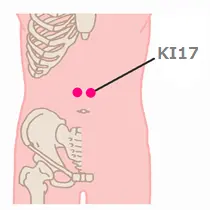
WHO : On the upper abdomen, 2 B-cun superior to the centre of the umbilicus, 0.5 B-cun lateral to the anterior median line.
Use for :
KI-18 石関
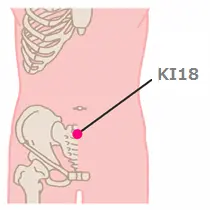
WHO : On the upper abdomen, 3 B-cun superior to the centre of the umbilicus, 0.5 B-cun lateral to the anterior median line.
Use for :
KI-19 陰都

WHO : On the upper abdomen, 4 B-cun superior to the centre of the umbilicus, 0.5 B-cun lateral to the anterior median line.
Use for :
KI-20 腹通谷
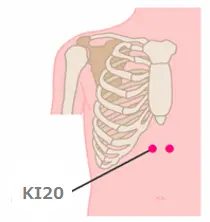
WHO : On the upper abdomen, 5 B-cun superior to the centre of the umbilicus, 0.5 B-cun lateral to the anterior median line.
Use for :
KI-21 幽門
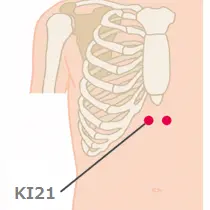
WHO : On the upper abdomen, 6 B-cun superior to the centre of the
umbilicus, 0.5 B-cun lateral to the anterior median line.
Use for : Nausea, Cough, Intercostal neuralgia, Bronchitis, Stomachache
KI-22 歩廊
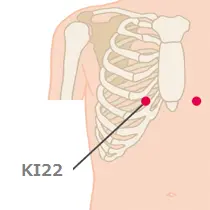
WHO : In the anterior thoracic region, in the fifth intercostal space, 2 B-cun lateral to the anterior median line.
Use for : Pleurisy, Angina, Pericarditis
KI-23 神封
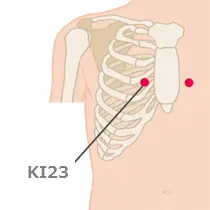
WHO : In the anterior thoracic region, in the fourth intercostal space, 2 B-cun lateral to the anterior median line.
Use for : Pleurisy, Angina, Pericarditis
KI-24 霊墟
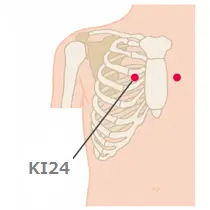
WHO : In the anterior thoracic region, in the third intercostal space, 2 B-cun lateral to the anterior median line.
Use for : Pleurisy, Angina, Pericarditis
KI-25 神蔵
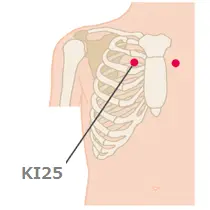
WHO : In the anterior thoracic region, in the second intercostal space, 2 B-cun lateral to the anterior median line.
Use for : Pleurisy, Angina, Pericarditis
KI-26 彧中
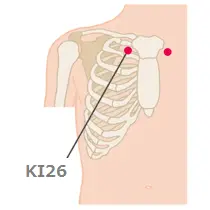
WHO : In the anterior thoracic region, in the first intercostal space, 2 B-cun lateral to the anterior median line.
Use for : Asthma, Bronchitis, Throat
KI-27 兪府
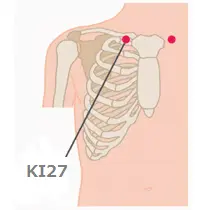
WHO : In the anterior thoracic region, just inferior to the clavicle, 2 B-cun lateral to the anterior median line.
Use for : Asthma, Bronchitis, Goitre(with CV21)
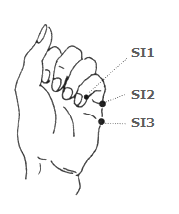
Small Intestine (SI) Meridian and Acu points
Small Intestine Meridian(SI) for Acupuncture and Moxabustion 手太陽小腸経
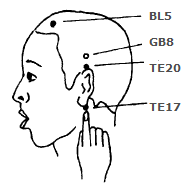
Triple Energizer Meridian (TE) and Acu points
Triple Energizer Meridian(TE) for Acupuncture and Moxabustion 正経十二経 – 手少陽三焦経

